Abstract
In this paper, we consider the effect of preservation technology cost investing on preservation equipment for reducing deterioration rate under two-level trade credit. The preservation technology cost is allowed for periodical upward or downward adjustments due to the time varying demand and the strategy of trade credit within the planning horizon. We establish a deterministic economic order quantity model for a retailer to determine his/her optimal preservation technology cost per replenishment cycle, the trade credit policies, the replenishment number and replenishment schedule that will maximize the present value of total profit. A particle swarm optimization with constriction factor is coded and used to solve the mixed-integer nonlinear programming problem by employing the properties derived from this paper. Some numerical examples are used to illustrate the features of the proposed model.
Similar content being viewed by others
References
Aggarwal S.P., Jaggi C.K.: Ordering policies of deteriorating items under permissible delay in payments. J. Oper. Res. Soc. 46, 658–662 (1995)
Chang C.T., Ouyang L.Y., Teng J.T., Cheng M.C.: Optimal ordering policies for deteriorating items using a discounted cash-flow analysis when a trade credit is linked to order quantity. Comput. Ind. Eng. 59, 770–777 (2010)
Chang H.J., Hung C.H., Dye C.Y.: A finite time horizon inventory model with deterioration and time-value of money under the conditions of permissible delay in payments. Int. J. Syst. Sci. 33, 141–151 (2002)
Chen C.K., Hung T.W., Weng T.C.: A net present value approach in developing optimal replenishment policies for a product life cycle. Appl. Math. Comput. 184, 360–373 (2007)
Chen C.K., Hung T.W., Weng T.C.: Optimal replenishment policies with allowable shortages for a product life cycle. Comput. Math. Appl. 53, 1582–1594 (2007)
Chung C.J., Wee H.M.: Green-product-design value and information- technology investment on replenishment model with remanufacturing. Int. J. Comput. Integr. Manuf. 23, 466–485 (2010)
Chung K.H.: Inventory control and trade credit revisited. J. Oper. Res. Soc. 40, 495–498 (1989)
Clerc, M.: The swarm and the queen: towards a deterministic and adaptive particle swarm optimization. In: Proceeding of Congress on Evolutionary Computation, vol. 3, pp. 1951–1957, Washington (1999)
Clerc M., Kennedy J.: The particle swarm—explosion, stability, and convergence in a multidimensional complex space. IEEE Trans. Evol. Comput. 6, 58–73 (2002)
Dave U.: On economic order quantity under conditions of permissible delay in payments by Goyal. J. Oper. Res. Soc. 36, 1069 (1985)
Eberhart, R., Kennedy, J.: A new optimizer using particle swarm theory. In: Proceedings of the 1995 6th International Symposium on Micro Machine and Human Science, pp. 39–43 (1995)
Eberhart, R.C., Shi, Y.: Comparing inertia weights and constriction factors in particle swarm optimization. In: Proceeding of Congress on Evolutionary Computation, vol. 1, pp. 84–88, San Diego (2000)
Gao Y., Zhang G., Lu J., Wee H.M.: Particle swarm optimization for bi-level pricing problems in supply chains. J. Glob. Optim. 51, 245–254 (2011)
Goyal S.K.: Economic order quantity under conditions of permissible delay in payments. J. Oper. Res. Soc. 36, 335–338 (1985)
Goyal S.K., Giri B.: Recent trends in modeling of deteriorating inventory. Eur. J. Oper. Res. 134, 1–16 (2001)
Hariga M., Alyan A.A.: A lot sizing heuristic for deteriorating items with shortages in growing and declining markets. Comput. Oper. Res. 24, 1075–1083 (1997)
Hsu P., Wee H., Teng H.: Preservation technology investment for deteriorating inventory. Int. J. Prod. Econ. 124, 388–394 (2010)
Huang Y.F.: Optimal retailer’s ordering policies in the EOQ model under trade credit financing. J. Oper. Res. Soc. 54, 1011–1015 (2003)
Kennedy, J., Eberhart, R.: Particle swarm optimization. In: Proceedings of the 1995 IEEE International Conference on Neural Networks, vol. 4, pp. 1942–1948 (1995)
Khanra S., Chaudhuri K.S.: A note on an order-level inventory model for a deteriorating item with time-dependent quadratic demand. Comput. Oper. Res. 30, 1901–1916 (2003)
Ouyang L.Y., Wu K.S., Yang C.T.: A study on an inventory model for non-instantaneous deteriorating items with permissible delay in payments. Comput. Ind. Eng. 51, 637–651 (2006)
Sarker B.R., Jamal A.M., Wang S.: Supply chain models for perishable products under inflation and permissible delay in payment. Comput. Oper. Res. 27, 59–75 (2000)
Teng J.T.: On the economic order quantity under conditions of permissible delay in payments. J. Oper. Res. Soc. 53, 915–918 (2002)
Teng J.T., Chang C.T., Chern M.S., Chan Y.L.: Retailer’s optimal ordering policies with trade credit financing. Int. J. Syst. Sci. 38, 269–278 (2007)
Tsao Y.C.: Two-phase pricing and inventory management for deteriorating and fashion goods under trade credit. Math. Methods Oper. Res. 72, 107–127 (2010)
Tsao Y.C., Sheen G.J.: Dynamic pricing, promotion and replenishment policies for a deteriorating item under permissible delay in payments. Comput. Oper. Res. 35, 3562–3580 (2008)
Yang C.T.: The optimal order and payment policies for deteriorating items in discount cash flows analysis under the alternatives of conditionally permissible delay in payments and cash discount. TOP 18, 429–443 (2010)
Yang P.C., Wee H.M., Liu B.S., Fong O.K.: Mitigating hi-tech products risks due to rapid technological innovation. Omega 39, 456–463 (2011)
Yu J.C.P., Wee H.M., Widyadana G.A., Chang J.Y.: The effects of inflation and time value of money on a production model with a random product life cycle. Asia Pac. J. Oper. Res. 27, 437–456 (2010)
Author information
Authors and Affiliations
Corresponding author
Rights and permissions
About this article
Cite this article
Dye, CY., Hsieh, TP. A particle swarm optimization for solving lot-sizing problem with fluctuating demand and preservation technology cost under trade credit. J Glob Optim 55, 655–679 (2013). https://doi.org/10.1007/s10898-012-9950-z
Received:
Accepted:
Published:
Issue Date:
DOI: https://doi.org/10.1007/s10898-012-9950-z




